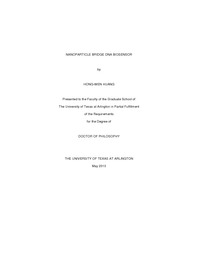
ATTENTION: The works hosted here are being migrated to a new repository that will consolidate resources, improve discoverability, and better show UTA's research impact on the global community. We will update authors as the migration progresses. Please see MavMatrix for more information.
Show simple item record
| dc.contributor.author | Huang, Hong-Wen | en_US |
| dc.date.accessioned | 2010-07-19T19:55:06Z | |
| dc.date.available | 2010-07-19T19:55:06Z | |
| dc.date.issued | 2010-07-19 | |
| dc.date.submitted | January 2010 | en_US |
| dc.identifier.other | DISS-10691 | en_US |
| dc.identifier.uri | http://hdl.handle.net/10106/4953 | |
| dc.description.abstract | A new DNA sensing method is demonstrated in which DNA hybridization events lead to the formation of nanoparticle satellites that bridge two electrodes and are detected electrically. The hybridization events are exclusively carried out only on specific locations, the surfaces of C-ssDNA modified 50 nm GNPs. The uniqueness of this work is that only a small number of T-ccDNA molecules (<10) is required to form the nanoparticle satellites, allowing ultra-sensitive DNA sensing. The principle of this new DNA sensing technique has been demonstrated using target DNA and three-base-pair-mismatched DNA in 20nM concentrations. Three single-stranded DNA (ssDNA) system is used in our experiment which includes Capture-ssDNA (C-ssDNA), Target-ssDNA (T-ssDNA) and Probe-ssDNA (P-ssDNA). Both C-ssDNA and P-ssDNA are modified by a thiol group and can hybridize with different portions of T-ssDNA. T-ssDNA requires no modification in three ssDNA system, which is beneficial in many applications. C-ssDNA modified 50nm gold nanoparticle (C-50au) and P-ssDNA modified 30nm gold nanoparticle (P-30au) are prepared through the reaction of thiol-gold chemical bonding between thiolated ssDNA and gold nanoparticle (GNP) (C-ssDNA with 50nm GNP, P-ssDNA with 30nm GNP). We controllably place the C-50au only on the SiO₂ band surface (~ 90nm width) between two gold electrodes (source and drain electrodes) by forming positively- and negatively-charged self-assembled monolayers (SAMs) on SiO₂ and gold surface, respectively. DNA modified GNP is negatively charged due to ionization of phosphate group on DNA back bone. C-50au therefore is negatively charged and can only be attracted toward SiO₂ area (repelled by negatively charged gold electrode surface). The amine group of positively-charged SAMs on SiO₂ surface is then passivated by converting to non-polar methyl functional group after C-50au placement. P-30au is first hybridized with T-ssDNA in the solution phase (T-P-30au formed) and is introduced into DNA detection device in which C-50au are immobilized on ~90nm width SiO₂ band (between two gold electrodes). The passivation step ensures every T-P-30au are attached only to C-50au through hybridization (T-P-30au will not be attracted toward SiO₂ surface or gold electrodes). GNP bridges are formed across the electrodes and provide an electrical path between two gold electrodes.We ensure that every T-P-30au only hybridizes on the surface of C-50au by (1) accurately controlling C-50au placement between two gold electrodes, (2) passivating positively-charged SAMs on SiO₂ surface after C-50au immobilization. When T-P-30au hybridize with C-50au on ~90nm wide SiO₂ surface, GNP bridges form and provide an electrical path between two gold electrodes even with only a few hybridization events. Experimental results show that even a few GNP bridges formed on SiO₂ band can provide a significant conductance change from an open circuit to a conductive circuit (current = 0.5 uA at voltage = 0.1 V with four GNP bridge). We also used 3-base-pair-mismatched ssDNA (3mm-ssDNA) as a control experiment, which always resulted in an open circuit (no GNP bridge formed). Our detection device is compatible with current CMOS fabrication technology and can be manufactured on a wafer scale. The direct electrical output of this DNA detection technique provides a promising basis for high-throughput screening (can be fabricated on a wafer scale) with no expensive equipment required. | en_US |
| dc.description.sponsorship | Koh, Seong Jin | en_US |
| dc.language.iso | EN | en_US |
| dc.publisher | Materials Science & Engineering | en_US |
| dc.title | Nanoparticle Bridge DNA Biosensor | en_US |
| dc.type | Ph.D. | en_US |
| dc.contributor.committeeChair | Koh, Seong Jin | en_US |
| dc.degree.department | Materials Science & Engineering | en_US |
| dc.degree.discipline | Materials Science & Engineering | en_US |
| dc.degree.grantor | University of Texas at Arlington | en_US |
| dc.degree.level | doctoral | en_US |
| dc.degree.name | Ph.D. | en_US |
| dc.identifier.externalLink | https://www.uta.edu/ra/real/editprofile.php?onlyview=1&pid=254 | |
| dc.identifier.externalLinkDescription | Link to Research Profiles | |
Files in this item
- Name:
- HUANG_uta_2502D_10691.pdf
- Size:
- 57.46Mb
- Format:
- PDF
This item appears in the following Collection(s)
Show simple item record


